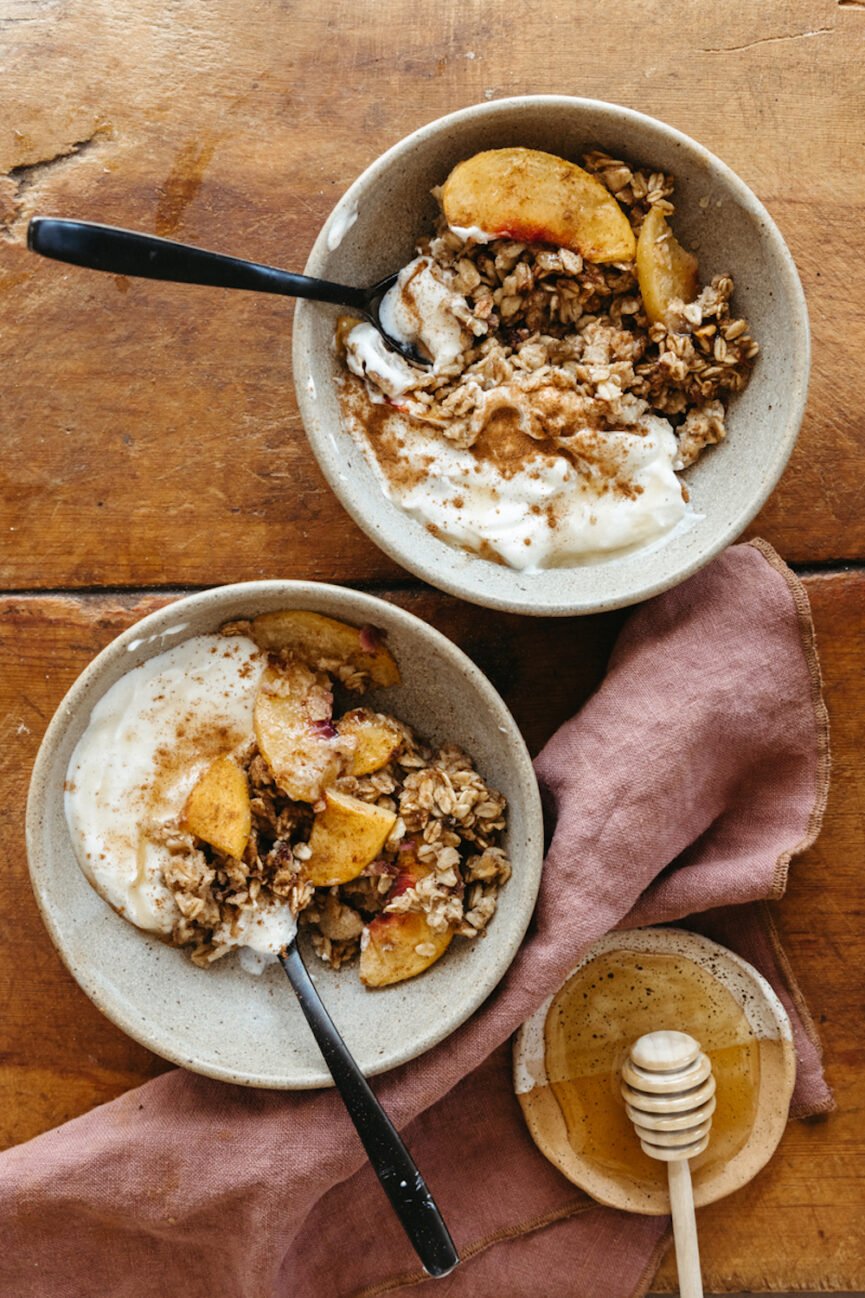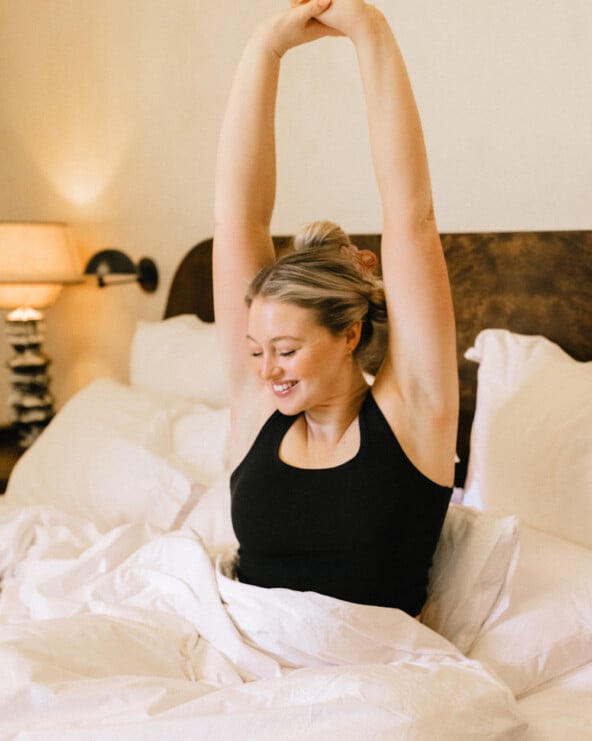We may receive a portion of sales if you purchase a product through a link in this article.
‘Tis the season to ditch our zealously-made New Year’s resolutions. Officially (and cynically) dubbed “Quitters Day,” January 12th has come and gone—and with it data suggesting a collective abandonment of our start-of-the-year goals. But if you’ve been here for a minute, you know that we actively practice and preach a more sustainable approach. We’re all about defining a vision and setting intentions that support how we want to feel. What this looks like for me? Waking up energized and motivated to tackle my daily to-do’s. And that led me to Andrew Huberman’s morning routine.
The entire Camille Styles team are enthusiastic subscribers of the Huberman Lab podcast. Regularly ranked the top health podcast in the world, the show’s episodes cover all areas of health, discussing topics like nutrition, sleep, breathwork, and more through the lens of neuroscience. As such, the conversations are research-driven, uncovering insights into how we can optimize performance to lead a more fulfilled and vibrant life.
So, it comes as no surprise that we’d look to host and neuroscientist, Andrew Huberman, Ph.D., for guidance on how to structure an ideal morning routine. And clearly, we’re not alone, as his millions of followers regularly seek out the nitty-gritty details as well (e.g., everything from his wake-up time to his workout to the components of his morning meal). And while I could find the answers in the deep rabbit hole that is the corner of YouTube dedicated to the subject, I decided to try it out myself. Spoiler: My life? Transformed.
Featured image from our interview with Iskra Lawrence.


What is Andrew Huberman’s morning routine?
Huberman’s podcast details the steps and benefits of his morning routine. In it, you’ll find tasks that support both mental and physical well-being—everything from hydration to stretching to yes, cold exposure. Here’s a breakdown.
Start with an early wake-up time.
Specifically, between 5 and 6 a.m. As someone who’s always naturally gravitated toward an earlier wake-up call, this wasn’t too much of a departure from what I already practiced. Because I aim for a bedtime of around 9:30 (lights out, sleep mask on), I wake up at 6 a.m. to ensure a solid 8.5 hours. Waking up early can help regulate your circadian rhythm, leading to more sustained energy throughout the day. If you find this difficult, considering investing in a sunrise alarm clock (we named the Hatch Restore 2 our favorite). Rather than spiking your cortisol with a jarring notification, it helps you wake up gradually with a gentle alarm.
Get natural light.
Aim for natural sun exposure within an hour of waking up. This is a surefire way to reset your internal clock—and can make that first step of rising early all the easier. Candidly, I found this the most difficult step in Andrew Huberman’s morning routine, as I started my experiment in the middle of a bleak Chicago winter. But even an overcast stroll outside counts! I bravely bundled up in my parka and ventured out for a quick 10-minute (silent) walk. While movement is a bonus, you can also reap the mood-boosting benefits by simply sipping your morning H20 on your porch or balcony.


Rehydrate your body.
As in, water first thing. We all know that prioritizing hydration throughout the day is important, but downing a glass immediately in the AM not only supports digestion but can lead to stronger focus. Supercharge your sip with lemon juice or consider chlorophyll water. While more research is needed, there is evidence to suggest chlorophyll can support healthy skin and aging. I love Juna’s Detox Drops as a beneficial boost or AG1 for the trifecta of vitamins, minerals, and probiotics.
Meditate.
While Huberman swears by yoga nidra, I have a hard time getting past my love-hate relationship with the practice. He suggests aiming for 10 minutes to promote mental clarity and reset your nervous system before diving into the stressors of your day. This is one part of the morning routine that I often modify. I’ll rely on a guided meditation through either Headspace or the Superhuman app. But more often than not, I’ll sit cross-legged on the floor and practice a few minutes of breathwork. Doing this, I find I’m less distracted by the challenge of quieting my mind and can instead lean into the grounding focal point of my breath.


Stretch it out.
I’ve grown more intentional about prioritizing mobility as I age and stretching more consistently has become a key cornerstone of that goal. Huberman is aligned and encourages a quick morning stretch. Doing so benefits everything from posture to reduced stress and is a solid habit to offset long periods of sitting during the work day. These are some of our favorite morning stretches to help maximize your morning routine.
Make time for movement.
While I’m a dedicated morning fitness fan (either barre3 or an at-home FORM workout are my faves), your morning movement can look however you’d like. Maybe that’s going for a long walk through your neighborhood or flowing through a quick yoga routine, or perhaps you’re a HIIT or strength training junkie. Whatever resonates and feels good for your body is the routine to follow.


Eat a nourishing breakfast.
The timing of his first meal of the day is the one element of Andrew Huberman’s morning routine that I actively chose to opt out of. He supports and practices time-restricted eating—often delaying his first meal until the early afternoon. But as someone with a history of eating disorders, I know that it’s not appropriate for me to adopt this habit. What’s more, some experts assert that intermittent fasting can negatively impact women’s hormones and fertility.
The part that resonates? How Huberman structures his first meal of the day. He prioritizes quality sources of protein, such as a few scrambled eggs (with pasture-raised being the gold standard). For sustained energy and regulated hunger levels, aim for a good balance of macronutrients, adding healthy fats and complex carbs to round out your plate.
Try cold exposure.
Did I say getting sunlight first thing was the hardest part of Andrew Huberman’s morning routine? Oops—I meant cold exposure. While interest in cold therapy has been trending over the past few years, I’ve found it hard to take the (literal) plunge. However, exposing our bodies to cold temperatures has been shown to strengthen immunity, boost your mood, reduce inflammation, and more. And while an ice bath is ideal, you can experience similar benefits by taking a cold shower.
Delay your caffeine intake.
Love your morning cuppa right after rising? Huberman suggests delaying your habit—by two hours, specifically. Painful, I know. But by prioritizing both sun exposure and exercise first, you’ll be able to avoid the afternoon energy slump. If you’re tempted to keep your energy high by pounding coffee after that first cup, one word: don’t. And according to Huberman, cut off all caffeine intake after 2 p.m. to avoid disruptions to your sleep.


The Takeaway
While others are chugging their way through the 75 Hard Challenge, I’ve found that following Andrew Huberman’s morning routine is a more sustainable way to still get a healthy start to the day. When it comes to building strong, supportive habits, working within a framework—rather than being rigidly strict about your rituals—ensures an easier return when you’ve “fallen off” the so-called wagon. I like that Huberman encourages certain habits such a movement, where you can adapt the step to align with what feels best for you.
It’s certainly not easy, but sticking to Andrew Huberman’s morning routine is possible because of the immediate benefits I experience in both my body and mind. Stretching and exercising first thing allows me to feel more energized in my work tasks. Practicing breathwork (and the occasional meditation) helps me start my day focused and motivated. And completing each step—yes, even my minute-long cold shower—lets me start the morning with a sense of accomplishment. It’s the snowball effect in action, leading to other small, but significant wins all throughout the day.






